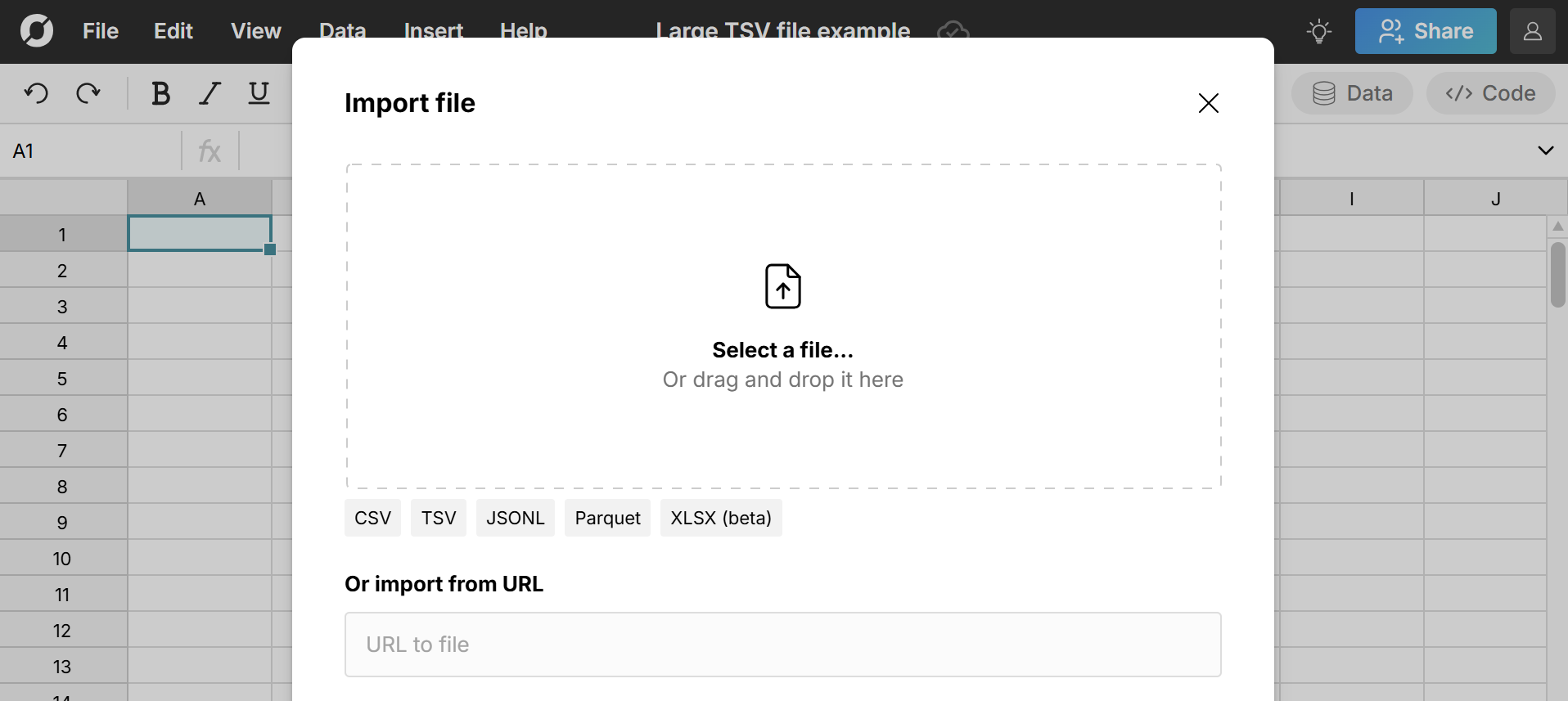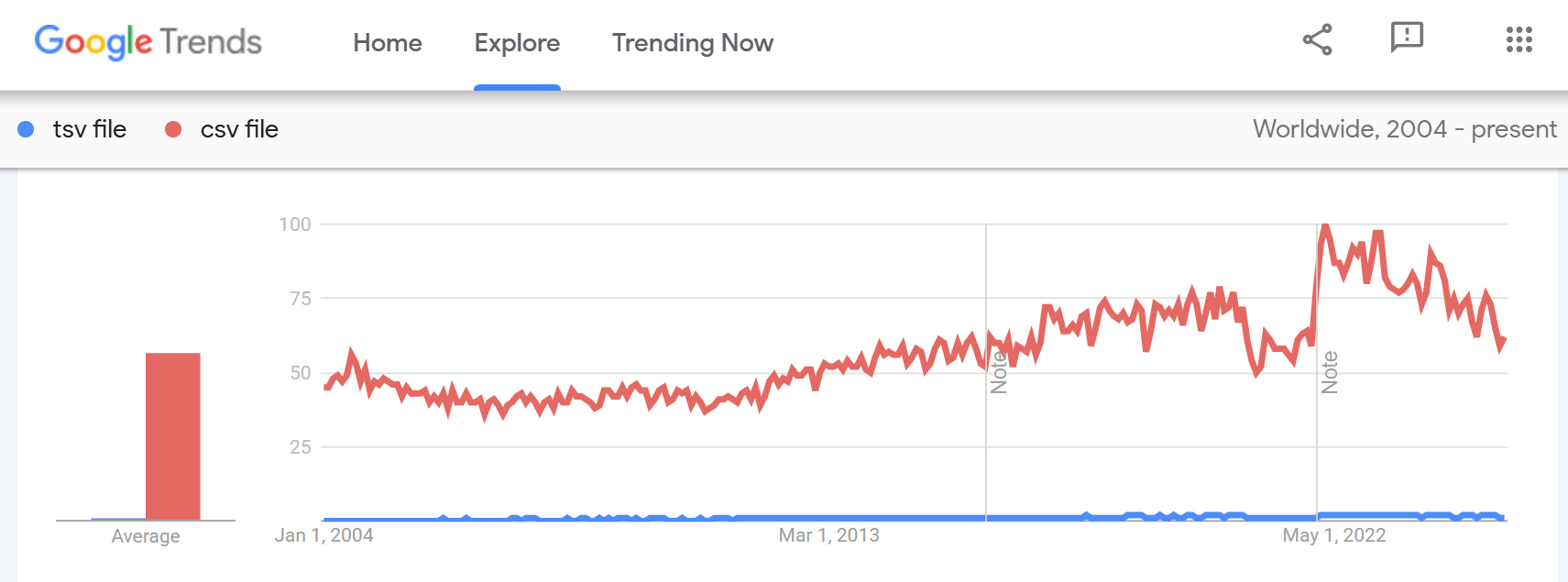Row Zero makes it easy to open large TSV files online in a spreadsheet with a simple one-click import. Row Zero is a powerful spreadsheet that works like Excel and Google Sheets but can handle 1000x bigger datasets. Row Zero will also automatically unzip and open TSV.gz files.
To get started, sign up for free and then import your TSV file. Continue reading for more info on opening and editing TSV files.
- How to open large TSV files
- How to open a TSV.gz file
- Why Row Zero is best for big TSV files
- Maximum TSV file size
- Common TSV import errors
- TSV vs CSV files
How to Open a Large TSV File:
Row Zero is a powerful spreadsheet built for big data that easily opens large TSV files online. Here's how in 3 easy steps:
Open up a workbook in Row Zero
Login or sign up for free and open a workbook.Import your big TSV file: In the top navigation, click Data to open a TSV file directly from your computer, a URL, or Amazon S3.


View and edit your TSV file as a spreadsheet
Your big TSV file is now a Row Zero spreadsheet. You can edit your TSV file, filter, sort, write formulas, create pivot tables, chart, and more.
How to Open a TSV.gz file
Large TSV files are often compressed using gzip in order to reduce the file size, resulting in a TSV.gz file. Row Zero automatically unzips and opens TSV.gz files. It's just as simple as opening any other file. Just go to Data, Import from file, and select your TSV.gz to open it. You cannot open a TSV.gz file in Excel or Google Sheets, so Row Zero is your best option.
Open a TSV.gz file in Row Zero
Why Row Zero is best for big TSV files:
Row Zero is a very powerful spreadsheet that is designed to work well with large datasets. Row Zero works like Excel but can handle datasets 1000x bigger than Excel's limits and is significantly faster than Excel and Google Sheets for working with big data. Row Zero easily opens TSV too large for Excel and makes it easy to clean, edit, and analyze TSV files with 200+ spreadsheet functions, filtering, sorting, pivot tables, charts, etc.
Row Zero has a Free tier that lets you open, analyze, and edit large TSV files in 1 workbook with unlimited sheets, a Pro tier for $10/month with unlimited workbooks and the ability to convert TSV to CSV, and a Business tier for $20/month that lets you import your clean TSV file to a database or data warehouse, among other features.
Note: Row Zero also supports a variety of large file formats including large CSV files, TXT files, parquet, JSONL, XLSX, etc. You can also connect directly to your database or data warehouse (e.g. Snowflake, Redshift, Postgres, etc.) to dynamically import data or write back cleaned spreadsheet data to your data warehouse, which is helpful for data preprocessing and cleaning use cases.
Maximum TSV file size
There is no TSV row limit or max TSV file size for the format, but there is a practical limit when a TSV file is too large to open and be useful and most applications have data limits. It's common to compress very large TSV files using the GZIP algorithm, which creates a TSV.gz file that is easier to store and transfer. Row Zero is the best spreadsheet for opening large TSV files and TSV.gz files. Here's a breakdown of TSV row limits by spreadsheet: 
- Row Zero - The Row Zero data limit is 2,147,483,647 rows and 18,278 columns (ZZZ). The free plan can handle 10s of millions of rows and open TSV files up to 5GB. Enterprise plans can handle much larger TSV files and billion row datasets.
- Microsoft Excel - The Excel row limit is 1,048,576 and column limit is 16,384 (XFD), so you cannot open TSV files in Excel over these limits.
- Google Sheets - The Google Sheets limit is 10 million cells. Google Sheets also has a TSV import limit around 100MB, so you can't open large TSV files in Google Sheets.
- Apple Numbers - The Apple Numbers row limit is 1 million rows and 1,000 columns.
- Libre Office - The Libre Office row limit is 1,048,576 and column limit is 1,024 (AMJ).
As you can see, Row Zero is the only spreadsheet application that opens very large TSV files. Row Zero easily opens TSV files more than 1 million rows and is your best choice to open a big TSV file online without writing code.
Common TSV Import Errors
The TSV file format has no data validation. You can add the .tsv file extension to any plain text file, so it's fairly common to have a TSV file with errors. When you open a TSV file, the application attempts to account for errors, but some errors will cause your TSV file to fail to open or parse correctly. Here are some common reasons why a TSV file won't open or import correctly:
- Inconsistent row lengths: If some rows have more or fewer columns than the header, it can cause parsing issues and misaligned data.
- Embedded tabs: If tabs appear inside a field value, it can break the parsing logic, so you'll need to escape or remove embedded tabs or wrap fields in quotes.
- Incorrect or inconsistent delimiter: If the file has a .tsv extension but doesn't consistently use tabs as the delimiter (e.g. uses spaces or commas) it can cause import issues.
- The TSV file is too big for your program - Most applications have a file import limit. Legacy spreadsheets like Excel and Google Sheets have a data limit around 1 million rows. Row Zero can open much larger TSV files, but if your file is more than a billion rows, you'll want to use a database to work with your file.
- Your program doesn't support TSV files - CSV is the most common file format supported across web applications. If your program doesn't support TSV import, then you'll likely need to convert your TSV file to CSV, which you can do with a spreadsheet, text editor, or python.
TSV vs CSV files
The main difference between TSV and CSV is the delimiter used to separate values. TSV stands for Tab-Separated Values and CSV stands for Comma-Separated Values. So TSV uses tabs and CSV uses commas. Here are the key differences between TSV and CSV files:
- Delimiter: CSV is comma (,) and TSV is tab (\t)
- File extension: .csv for CSV and .tsv for TSV
- Readability: Large TSV files are typically less human-readable in plain text editors than CSV files since the data is spread out more and harder to visually distinguish. There is no difference in spreadsheets for viewing TSV vs CSV files.
- Handling commas in data: CSV requires quoting fields with commas, whereas TSV files are less likely to need quoting
- Quoted values: CSV files often need to enclose fields in quotes to handle fields with commas, newlines, or quotes. This is less necessary with TSV files.
- File size limit: Both TSV and CSV files have no limit on data size, but many applications that open TSV and CSV files have data limits.
- Popularity: CSV files are more common than TSV files by a wide margin, which is evident in Google Trends data:

Both CSV and TSV file formats are plain text and easy to process in scripts or spreadsheet programs. CSV files are more universally supported and are the default file format for data import/export for most tools. TSV offers more reliability when dealing with messy text data that includes punctuation and can provide a simpler structure without needing quotes or escape characters. While neither have a size limit, larger TSV and CSV files will typically be compressed as TSV.gz or CSV.gz files for storage and transfer. In addition, other file formats like parquet files are typically used for very large datasets since they are better optimized for handling large data.
Conclusion
It can be a challenge to open big TSV files in Excel, Google Sheets, or text editors due to their data limits. Row Zero is a powerful spreadsheet that makes it easy to open very large TSV files with a simple file import. Once imported, you can easily edit your TSV file and analyze with pivot tables, charts, and spreadsheet functions. You can try Row Zero for free to open a large TSV file in seconds.